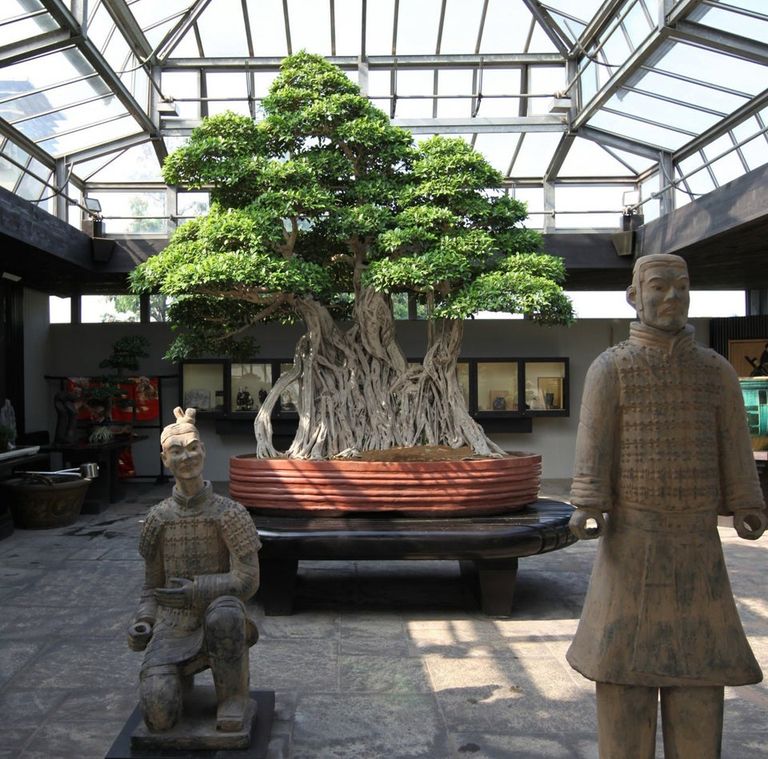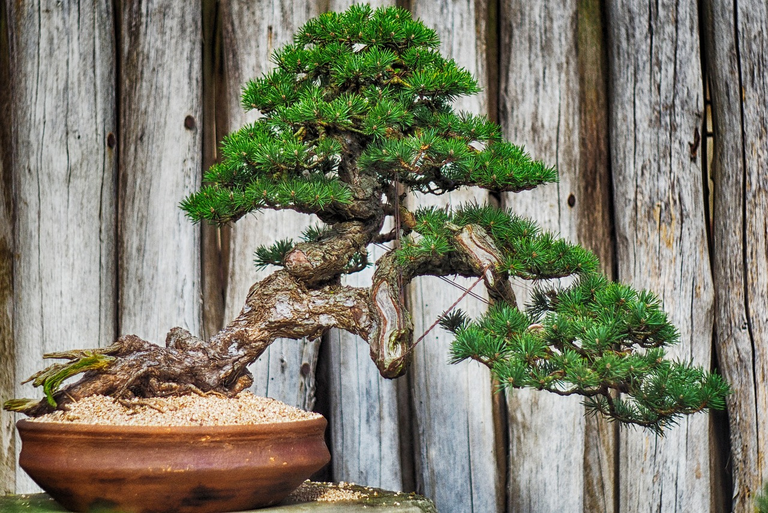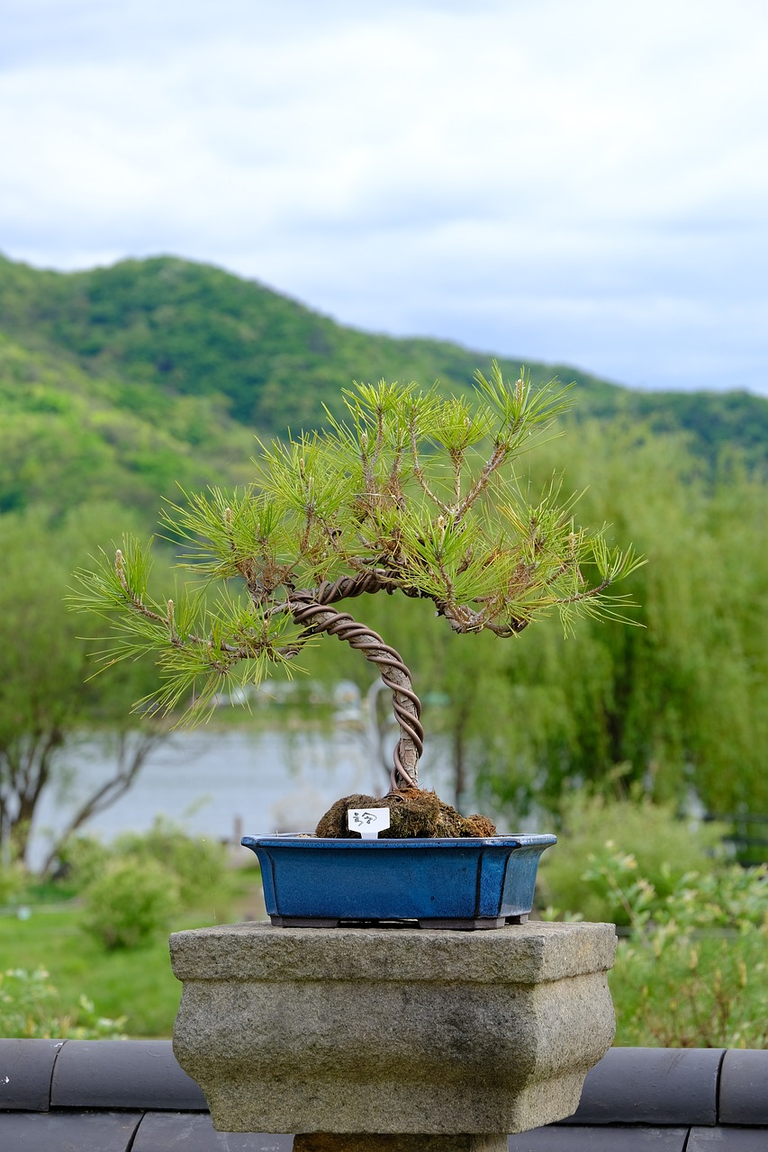
El bonsai es una técnica milenaria, un arte al cuál algunos se acostumbran al ver una plantita en miniatura en el supermercado. Pero es mucho más que eso.
Detrás de esa técnica hay siglos de estudio, de dedicación. Es una forma de vida en la cultura asiática, no solo japonesa.
Es el don de la paciencia y la calma transmitidas en la acción de cuidar y perfeccionar una planta.
Literalmente traducida la palabra bonsai es "naturaleza en miniatura". Pueden ser una o varias plantas.
Pero la esencia es esa.
Una vez vi en una exposición en Italia la composición de un bosque bonsai en una maceta de 30 cms de diámetro. Imagínense Uds. desarrollar no una sino varias plantas en miniatura en ese espacio.
En Japón hay familias que se transmiten ese oficio, mestiere o profesión (cada uno emplee el término que más le gusta) de generación en generación
Conocí un maestro japonés heredero de toda una generación de bonsaístas. El era algo así como el tataranieto. Hablo de personas que durante dos siglos se han ido pasando no solo los conocimientos sino también las plantas. Esos bonsai que hoy tienen 200 años.
Mis bonsai tienen, modestamente, muchísimos menos años. Pero son propios. "Hechos a mano" como dicen mis amigos. De la semilla o el esqueje hasta la planta como tal.

Behind that technique there are centuries of study, of dedication. It is a way of life in Asian culture, not just Japanese.
It is the gift of patience and calm transmitted in the action of caring for and perfecting a plant.
Literally translated the word bonsai is "nature in miniature". They can be one or more plants.
But the essence is that.
I once saw in an exhibition in Italy the composition of a bonsai forest in a pot 30 cm in diameter. Imagine you developing not one but several miniature plants in that space.
In Japan there are families that transmit this trade, mestiere or profession (each one uses the term that they like the most) from generation to generation
I met a Japanese teacher heir to a whole generation of bonsaists. He was something like the great-great-grandson. I am talking about people who for two centuries have passed on not only knowledge but also plants. Those bonsai that are 200 years old today.
My bonsai are modestly much younger. But they are their own. "Handmade" as my friends say. From the seed or the cutting to the plant as such.

Cómo crear un bonsai de enebro. / How to create a juniper bonsai.

El enebro es una de las plantas que mejor se adaptan par hacer un bonsai.
Hay en total unas 12 especies pertenecientes al género botánico Juniperus o Enebro.
Como planta en la naturaleza podemos ver que florece en primavera y madura sus frutos al segundo o tercer año.
Este permite ver una misma plantas diversos frutos con distinto estado de maduración.
El enebro encuentra su origen en el Este asiático especialmente enJapón, China y Corea, por otro lado países en los cuales el bonsai ha alcanzado un altisimo nivel.
En estado natural habitualmente alcanza una altura de 2-4 metros aunque se han encontrado ejemplares excepcionales de hasta 10 metros de altura.

Juniper is one of the plants that best adapts to making a bonsai.
There are a total of 12 species belonging to the botanical genus Juniperus or Juniper.
As a plant in nature we can see that it blooms in spring and ripens its fruits in the second or third year.
This allows you to see the same plants different fruits with different states of maturation.
The juniper finds its origin in East Asia, especially in Japan, China and Korea, on the other hand countries in which bonsai has reached a very high level.
Juniper is one of the plants that best adapts to making a bonsai.
There are a total of 12 species belonging to the botanical genus Juniperus or Juniper.
As a plant in nature we can see that it blooms in spring and ripens its fruits in the second or third year.
This allows you to see the same plants different fruits with different states of maturation.
The juniper finds its origin in East Asia, especially in Japan, China and Korea, on the other hand countries in which bonsai has reached a very high level.
In its natural state it usually reaches a height of 2-4 meters although exceptional specimens have been found up to 10 meters high.In its natural state it usually reaches a height of 2-4 meters although exceptional specimens have been found up to 10 meters high.
Primeros pasos. / First steps
Partimos del hecho de tener una plantita ya desarrollada. A esta condición podemos llegar:
- Comprándola.
- Sembrándola y esperando su crecimiento (es la técnica que yo prefiero aunque es mucho más lenta).
- Reproduciéndola por esqueje.
El primer paso el sacar la tierra superficial de la maceta o contenedor donde la hemos cultivado para ver donde comienza a verse el inicio de las raíces.
Levantamos con delicadeza la planta de la maceta y sacamos con un bastoncito la tierra hasta que sea bien visible la raíz principal.
Es importante para definir el perfil de la planta y para ver desde que posición comenzamos a trabajar con el tronco y las ramas principales.
El próximo paso es remover con cautela la ramas muertas y las ramitas más pequeñas o aquellas que no presenten un desarrollo vigoroso y vivaz.

We start from the fact that we have an already developed plant. We can reach this condition:
Buying it.
Planting it and waiting for its growth (it is the technique that I prefer, although it is much slower).
Reproducing it by cutting.
The first step is to remove the surface soil from the pot or container where we have grown it to see where the beginning of the roots begins to be seen.
Gently lift the plant from the pot and remove the soil with a stick until the main root is clearly visible.
It is important to define the profile of the plant and to see from which position we begin to work with the trunk and the main branches.
The next step is to carefully remove the dead branches and the smallest twigs or those that do not present a vigorous and lively development.
Próximo paso: la poda verdadera. / Next step: true pruning.
Lo que hicimos en el paso anterior fue limpiar la planta no podarla.
La poda verdadera empieza ahora.
Si queremos crear un design más compacto eliminamos la punta de la planta.
La poda es considerada la acción más difícil es la creación del bonsai y la de mayor riesgo.
Eliminamos algunas de las ramas inferiores para dejar el tronco al descubierto una superficie lo suficientemente amplia para permitirnos trabajar sin problemas.
Podemos podar sin problemas, es decir sin que signifique un daño para la planta, hasta un 33% de la misma, es decir 1/3
A este punto la primera fase verdadera y propia en la creación de un bonsai que es la poda ha terminado.
Nos vemos en el próximo tutorial que trataré sobre la aplicación del alambre o alambrado del bonsai como se lo conoce en la jerga popular.

What we did in the previous step was clean the plant, not prune it.
The real pruning starts now.
If we want to create a more compact design, we eliminate the tip of the plant.
Pruning is considered the most difficult action in the creation of bonsai and the one with the highest risk.
We removed some of the lower branches to expose the trunk with a large enough area to allow us to work without problems.
We can prune without problems, that is to say without causing damage to the plant, up to 33% of it, that is to say 1/3
At this point the first real phase in creating a bonsai, which is pruning, is over.
See you in the next tutorial that I will deal with the application of the bonsai wire or wiring as it is known in the popular jargon.

Fuente/Source: Pixabay.
| Blogs, Sitios Web y Redes Sociales / Blogs, Webs & Social Networks | Plataformas de Contenidos/ Contents Platforms |
|---|---|
| Mi Blog / My Blog | The Ancient Art of Bonsai. |
| Red Social Twitter / Twitter Social Network | @hugorep |
Thank you for voting and supporting my blog posts @epistem.